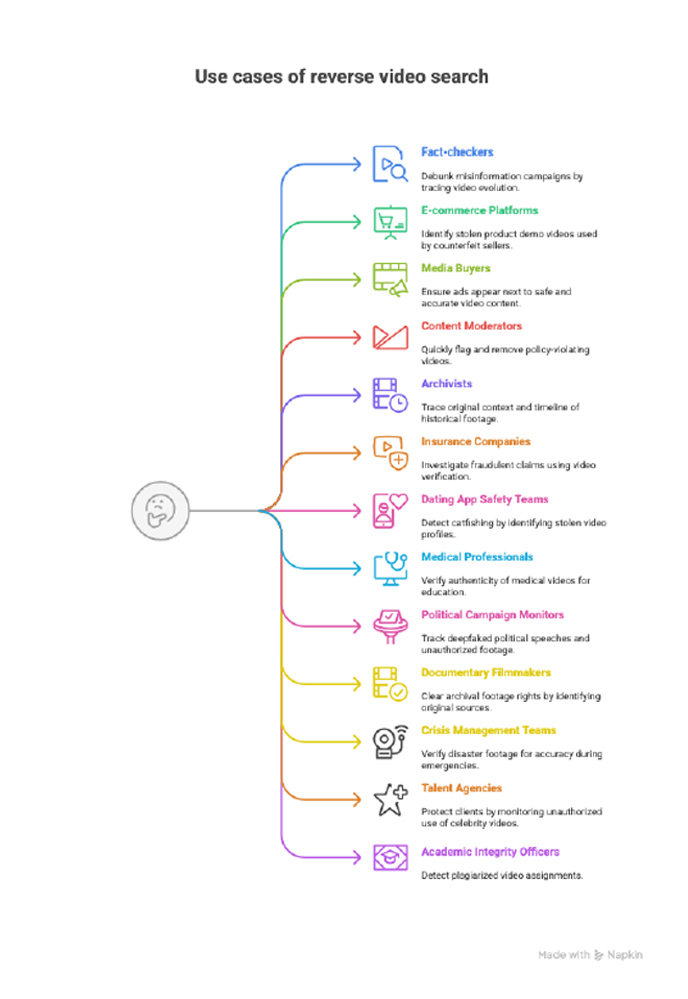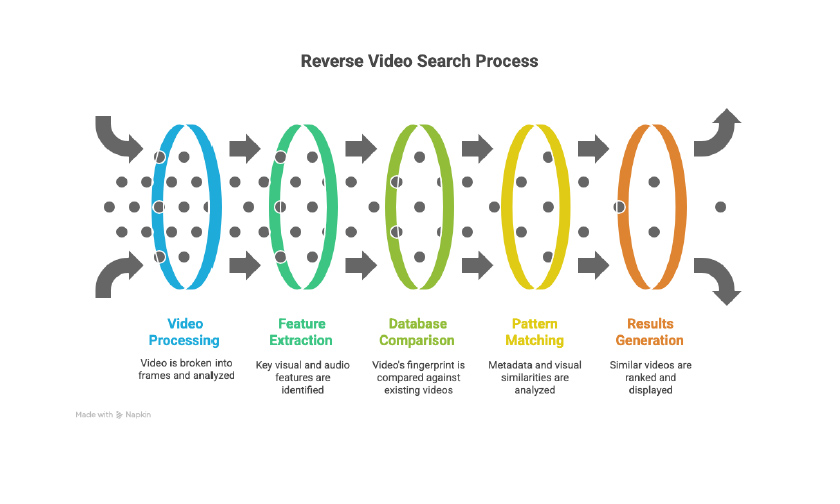Reverse video search : How it works, use cases, tools, and MORE

Reverse video search is all about finding information about a video. It’s done by using the video itself instead of entering words. You can use a clip, a screenshot, even a frame from the video to know its source, places where it has already appeared online and find other videos with similar content.
Alarming stats about videos
The need for reverse video search can be understood if you look at the below-mentioned statistics:
● Over 96% of fraud cases in 2023 involved some sort of manipulated media / deepfake technology. ZipDo
● Nearly half of creators say their user generated video content has been used without their permission. MASV
● An estimated 500,000 deepfakes were shared on social media in 2023 Fake News Statistics & Facts (2024) — Redline Digital
● Searches for “free voice cloning software” rose 120 percent between July 2023 and 2024 2024 Deepfakes Guide and Statistics | Security.org
● The global movie industry’s revenue losses from digital piracy are between $40 and $97.1 billion per year Piracy Is Back: Piracy Statistics for 2024
● Illegal streaming services account for more than a whopping 80 percent of global online piracy 37 Digital Piracy Facts and Statistics You Must Know in 2024
As you can see through the stats how widespread the misuse and misinformation around video content has become and that content can easily be taken totally out of the context and misrepresented at any point of time, and shockingly without users knowing anything about it.
On top of it, the massive scale of manipulated media, piracy and unauthorized use make it difficult to track the origin and authenticity of doubtful videos. This is why it makes sense for concerned individuals and organizations to leverage advanced technologies presently available to counter this pressing challenge.
This is where we take the help of reverse video search technology.
What is reverse video search?
It is a technology that integrates various advanced technical components like machine learning and AI, video processing, database system, pattern recognition, search algorithms etc., to help you locate a video’s source, know where it’s been used, and trace similar or modified versions of the video available across online platforms.
Use cases and examples of reverse video search
Media, journalism and research
Journalists can locate the source of viral videos if they need to be added as part of reporting
Fact checkers can track how a video has been shared and gradually evolved across platforms
Documentary filmmakers can verify footage sources and secure licensing when needed
Scholars and researchers can ensure the authenticity of historical footage for their respective projects
Academic integrity officers can find plagiarized video submissions or stolen research clips.
Business, brands and marketing
Brands can use this technology to know if their ads or promotional videos have been reused without their knowing and permission.
Media buyers and advertisers can make sure that their ads don’t appear along with harmful or misleading content.
Talent agencies can monitor wrongful use of celebrity videos and promotional clips.
E-commerce platforms can spot fake product demos and stolen testimonials used by counterfeit sellers.
Safety, security and law enforcement
Law enforcement agencies use reverse image search to investigate misleading or illegally shared content.
Political campaign monitors can track manipulated campaign videos
Content moderators can detect revenge videos, harassment footage and policy violating clips.
Dating app safety teams can identify stolen video profiles and fake video calls used in scams.
Crisis management teams can verify if disaster footage is recent and accurate to location.
Legal, copyright and compliance
Lawyers can find evidence of copyright infringement.
Insurance companies can check if “accident” or “damage” videos were repurposed from events that are unrelated.
Education and professional development
Educators can find full versions of short clips for teaching and research.
Medical professionals can verify surgical procedure videos, training content, and patient testimonials before using them.
Creators and platforms
YouTubers can track unauthorized versions of their videos.
Social media platforms can find misleading or doctored viral videos.
Content moderators and platform teams can remove edited clips that are trying to bypass their detection technologies.

So, what are the benefits of reverse video search?
Reverse video search can help build trust and credibility by verifying video authenticity, protect intellectual property of original video content and prevent your content’s misuse.
It also saves time, effort and resources by automating the task of tracking sources and reducing spread of misinformation while improving the sanity of online platforms where videos are used.
Furthermore, it supports legal compliance and strengthens copyright enforcement.
Overall, in today’s video driven world, this technology is a must-have for concerned people and bodies.
How reverse video search works?
If we put it in simple words, reverse video search works by understanding the video you upload and then comparing it with content already available online.
This technology breaks the video into key frames, then uses visual recognition, metadata analysis etc., to look for related or similar content that are there across the web.
Once matches are found, it shows you results.

How to do reverse video search?
Note: When we talk about reverse video search, the technology often relies on reverse image search. While it may sound like the process works directly with the full video, in reality, to find information about a video, you need to upload a still frame from it, not the entire motion content or a clip.
Platforms to accomplish your reverse video search
Google Lens
Lens has strong integration with Google’s image database which is massive, meaning more chances of getting accurate results.
Yandex Images
Yandex images is another good option for image recognition and it can find results that may be missed by Google or Bing, however it’s not always the case.
Bing Visual Search
https://www.bing.com/visualsearch
Microsoft’s reverse image search tool is integrated with its Edge browser. It stands as a useful secondary option when Google Lens results are fetching limited information.
TinEye
Tineye is great for tracking reused or edited content and finding original sources. It comes with limited free searches and has premium options for extensive usage.
Berify
Berify can handle screenshots from videos and some direct video search options with subscriptions.
● More options:
SmallSEOTools Reverse Video Search
InVid plugin
Shutterstock Reverse Video Search
Note: In Shutterstock, you need to click on the camera icon in the search bar to get started with reverse video search. At the time of writing this article, the feature doesn’t appear to be there. It may be a temporary technical glitch.
The process of searching is almost the same across all platforms:
1. Choose a clear frame from the video you want to check.
2. Take a screenshot of that frame.
3. Upload the screenshot to the reverse video search platform
4. Review the results
Platform-native video rights and detection tools
● YouTube Content ID,
● Facebook Rights Manager
These two aren’t reverse search tools in the traditional sense, but they serve the same purpose of finding content within their own platforms.
YouTube Content ID scans all uploaded videos in it against a reference database and if their content is reused, it alerts the owners.
Creators can block, track or monetize those videos if they want.
Facebook Rights Manager – It automatically detects videos matching your content across Facebook and Instagram and also allows you to manage how they are used or request removal.
Reverse video search on your mobile phone
You can do reverse video search on your mobile using Google Lens, which is built into most Android phones and available through the Google app on iOS.
Google Lens on Play
To do a reverse search, pause your video at any moment, take a screenshot, and open it in Google Lens.
The tool will then scan the image and show visually similar matches that are related and possible sources of the content.
Limitations and challenges
Reverse video search although useful is however not without limitations. The biggest challenge, as mentioned above, is that you need to depend on screenshots, which means results depend on the quality and clarity of the frame that you choose.
If you make edits such as cropping, apply color filters or add text, it can confuse the search engines and lead to wrong or no matches. Also, videos that are new, privately shared or hosted on smaller platforms may not appear in search results at all.
Privacy and legal considerations
While reverse video search is a useful tool, it must be used responsibly. Uploading screenshots from private or sensitive videos without taking due consent and permission can raise privacy concerns and may even violate data protection laws in some places.
Using the technology to track individuals, expose identities or share non consensual content is not only unethical, but it can also lead to legal consequences.
Also, content that you discover might still be protected by copyright so reusing or redistributing it without proper permissions could result in infringement claims.
In short, always ensure that your use of reverse video search aligns with the concerned platform’s policies, privacy laws and intellectual property rights.
Our POV
Reverse video search has become more important than ever given today’s age is the age of information overload. There is nothing called ‘shortage of content’. It’s everywhere now, which also means there’s no surety every content we consume is authentic and is not written and shared for vested interests.
However, every technology must be used responsibly. In that sense, reverse video search must be used ethically and with understanding of its purpose and limitations. Also, it is not perfect and the technology still has miles to go. Nonetheless, it is not just a search utility. It is a defensive tool and a helping hand for people concerned about the sanity of original content.
FAQs
1. Will reverse video search find videos on private platforms?
Content behind logins or privacy restrictions don’t generally appear in search results
2. Can small edits or filters affect results?
Cropping, color changes, or text overlays among other edit forms, can make it harder for search engines to match a frame uploaded.
3. What to Do When Searches Return No Results
If a reverse video search doesn’t return any matches, it doesn’t necessarily mean the video is original. The content may be too new, private, hosted on smaller platforms or probably it has been edited. You can try by capturing multiple frames from different parts of the video, improve screenshot quality. If nothing helps, use alternative platforms.
4. How to handle false positives
Sometimes, search results may show visually similar videos that are not actually the same. Always cross-check the source, metadata, upload dates, and platform context before arriving at a conclusion.




